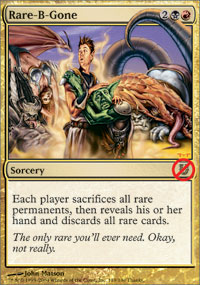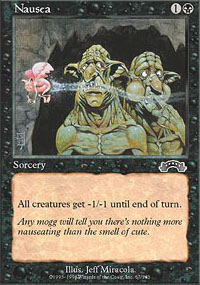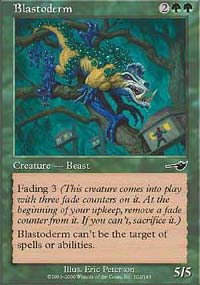Enter the Pauper

Yes!
First, color selection in Pauper. The colors are actually pretty balanced in terms of power level, although the format is skewed heavily towards aggro decks in much the same way and for much the same reason as limited is. Multicolor decks got a huge boost out of Ravnica, gaining the bounce lands and the signets, which largely liberated them from needing to rely on green for mana fixing. That said, it’s usually best not to go over two colors without playing green, and I have yet to find a legitimate reason aside from playing Slivers.dec to play more than three colors (And no, I’m not counting “Because I can,” as a legitimate reason). The multicolor awesomeness that was Ravnica carried over to Time Spiral with cards like Terramorphic Expanse (which is one hell of a good card, lemme just tell you) and Prismatic Lens. In fact, I’d go so far as to say that the Expanse should go in just about any Pauper deck you can stick it in, since it’s always useful to thin your deck in a format without a large number of draw spells outside of blue. It’s also awesome color fixing in multicolor decks, since you don’t have to dedicate as many spell slots to mana fixing when you can replace some colored lands with a fetch land.

I'm lonely in this format. Will you please
be my friend?
To follow up on my earlier comparisons to limited, Pauper is a much slower format than those you may be used to. Games tend to last more than ten turns unless you’re staring down a burn deck, in which case you’ll probably be toasty in about six. This leaves a lot of room for a lot of different strategies to compete without too much fear of being rolled by fast decks, although a properly designed weenie deck can be a great weapon here.
A final word before I move on: combo decks in Pauper tend to be things like Horseshoe Crab + Quicksilver Dagger, two to three card combos that tend to be clunky but fun. However, Empty the Warrens and Grapeshot have both made storm decks possible where they weren’t before, as all of the game-winning storm cards were in the uncommon slots. In fact, while we’re on the subject of Pauper Storm…
Purple Rain: A Common Storm Deck
When you’re going off with this deck, your blue mana is generally best spent either on an untap spell, or as colorless mana for your other spells. If you have Chromatic Stars in play, once you’ve exhausted the ritual effects in your hand it’s generally correct to use them to convert untapped Islands into red mana sources…and you get to draw cards while you’re at it. If you play Frantic Search, try not to discard spells unless they’re redundant Igni. Draw spells can refill your hand mid-combo (DO NOT spend red mana for the colorless costs if you can help it) and they increase the storm count as well. Also note that you can drop Clouds of Faeries or Grinning Igni early to block while you gear up for the Big Turn.
The House Dimir and Tog-less Tog
For those of you who don’t know (and that would most likely be a large chunk of my audience), I like blue, green, and black. Just about every deck I’ve made over the years has included at least one of those colors, and many of them have included two or more. Don’t ask me why – it was probably born from my love of multicolor when I got back into Magic in Invasion – but I really, really like those three colors. Consequently, some of my favorite “classic” decks in the game run blue, green, and/or black…which would probably explain some of my irrational love for Psychatog decks. Why am I mentioning this? Dunno, it just crossed my mind.
| Psychatog.dec, minus the PsychatogMagic OnlineOCTGN2ApprenticeBuy These Cards | |
|---|---|
|
4 Nightscape Familiar 4 Chilling Shade 4 Last Gasp 2 Ichor Slick 4 Accumulated Knowledge 3 Foresee 3 Repulse 3 Recoil 4 Counterspell 4 Rune Snag 2 Perplex | 4 Dimir Aqueduct 4 Terramorphic Expanse 9 Snow-Covered Island 6 Snow-Covered Swamp |
Well, for those of you not in the know, the old type 2 Psychatog decks of yore sought to win by getting to :5mana::symu::symu::symu::symb:, casting Upheaval, the playing a Psychatog onto an empty board with the mana the deck still had floating. Your hand and graveyard would now have enough stuff in each of them to attack with a gigantic – and quite often lethal – ‘Tog on your next turn. Unfortunately, Dr. Teeth (as he is also known) is an uncommon, so he’s disqualified right off the bat for this deck. However, the principles here are similar: the deck seeks to remove blockers, then win on the back of a really freakin big guy – in this case, Chilling Shade. The Shade made the cut because he has evasion, he’s cheap, and his pump ability requirements are really easy to satisfy without straining the deck too much. Nightscape Familiar is also a good card here, since it makes most of your spells cheaper and it’s devilishly hard to remove, so long as you keep :1mana::symb: open to regenerate it.
Another luminary in the deck is your pair of Perplex. The card can act either as a really, really good counterspell (since real card advantage is difficult to come by outside of blue), or as a tutor for a host of cards, mostly removal, but also your Shades. I suppose they could be Drift of Phantasms if you want the extra defense.
No Article is Complete Without the Rest of It
Okay, yeah, I said there were stompy decks in the format, and I wasn’t lying. Beatdown is a pretty powerful strategy in a format largely without mass removal, but even then, there’s shades of grey to deal with. White weenie? Mono-green beatdown? Hmmm…or how about…

RAWR! >:3
There are also a number of internal synergies in the deck to keep an eye out for. Horned Kavu can be used to rescue your fading creatures if you're so inclined, although the only ones that are usually worth it are the Blastoderms. Speaking of Blastoderm, that card is quite possibly one of the best creatures in the format. Why? It's big, it's cheap, and it's frustratingly difficult to deal with...in fact, the only way to really deal with it is to hope you can chump block it until it fades away. Hence, given the option to do so, you should always try to save a Blastoderm.
While we're on the subject of aggro decks in Pauper, let me just say that many of the aggro decks you build will probably benefit quite a bit from the addition of red for burn. Unlike creature removal in black, burn can always be pointed at your opponent's face to win the game. In a format as creature-based as this one, playing in a color without access to lots of cheap evasion dudes will leave you liable to stall on the ground. Burn can help close those last few points of damage when your savage offense has ground to a halt.
...and Here's the Rest of It
One of the awesome things about Pauper is that it's a kind of "filter format," or a card legality filter that can be applied to any existing format. In other words, you can play Pauper in just about any way you can come up with: Pauper type 2, Pauper Vintage, Plain Ol' Pauper, hell, even Pauper Block Constructed. All of the decks I've listed up until now were built under the assumption that any and all commons in the game could be used as a full playset in your deck. For those of you who are a bit paranoid about having such unrestricted deck building freedom, I'll include a new Standard Pauper deck before I roll the credits.
Well, that's just about a wrap for Pauper. This article is meant to just give those of you unfamiliar with it a basic introduction to a format that's quite a bit like the bastard child of Constructed and Limited. Stay tuned in the future for articles on strategy and all that good stuff.
One more thing, before I go. Pauper is an incredibly flexible format. As I said, not only is it a filter format, it's also an easily modifiable one within your play group. Is a certain common getting you down? Banhammer it. Don't want to play cards that haven't been printed as commons for all of their printings? Don't play with them. Have an itch for something painfully contorted? Play Pauper Two-Headed Giant Time Spiral Block Constructed where every player has to play a different deck, and no one can play Slivers (I'd like to see that one...). Pauper is an incredibly fun format, subject only to your card pool and the whims of your friends. Go out there and build something.
Comments